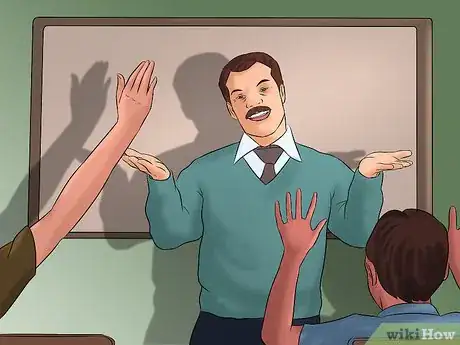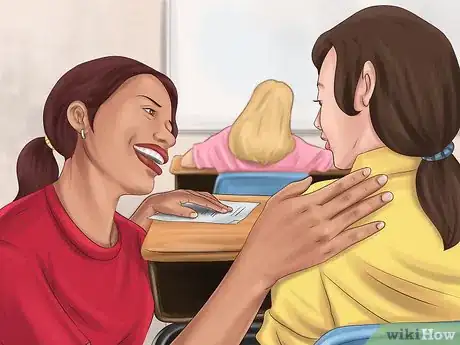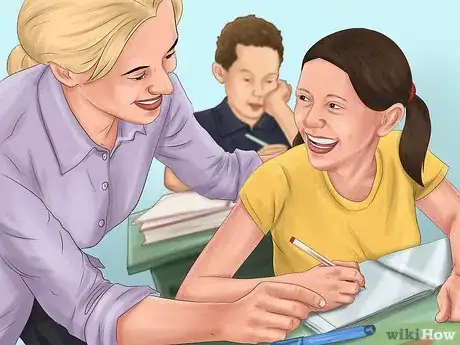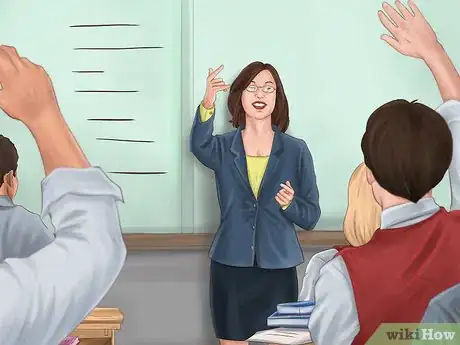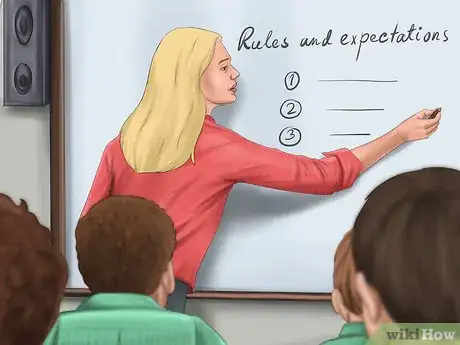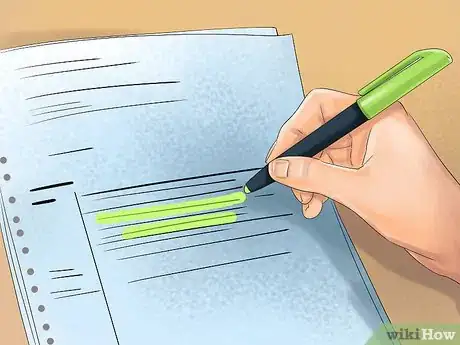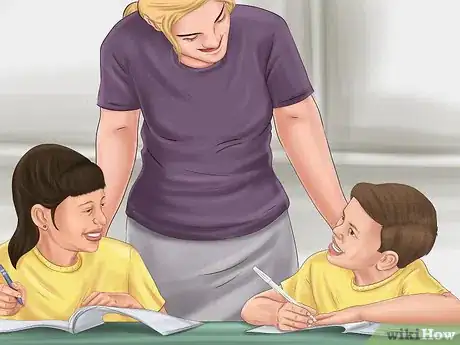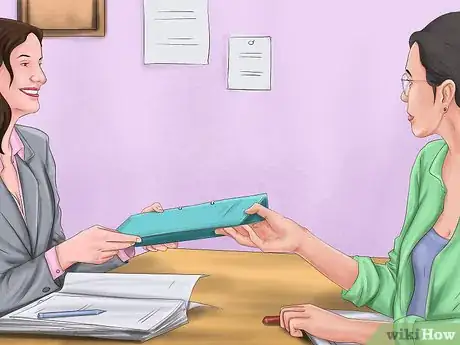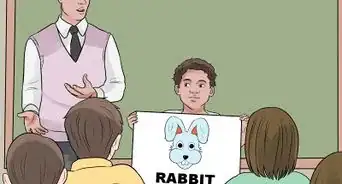This article was co-authored by Laura Reber, SSP. Laura Reber is a school psychologist and founder of Progress Parade, an organization that provides 1:1 online tutoring with hand-picked specialists to students with academic needs, ADHD, learning disabilities, autism, and social-emotional challenges. Laura works with a team of school psychologists and specialized teachers to create personalized approaches for homework support, academic intervention, homeschooling, unschooling, and more. Laura holds a BS in Psychology from Truman State University and a Specialist in School Psychology degree (SSP) from Illinois State University.
This article has been viewed 82,210 times.
Behavioral and emotional problems are among the most common health issues affecting school age children. They are also some of the most likely to affect academic performance.[1] Failure to address these issues can cause lifelong problems. For teachers and other individuals working with children, it is important to understand how to work effectively with these students. Doing so can both decrease the stress experienced by educators and help students learn in the face of challenges.
Steps
Identifying the Problem
-
1Look for patterns. There are many different types of emotional and behavioral problems that can affect students. A teacher's job is not to make a formal diagnosis, but it's a good idea to be on the lookout for patterns of behavior that could be signs of a problem.
- Know the signs of internalized problems. Students with internalized emotional problems are typically withdrawn, anxious, or depressed.[2] Signs include isolation from peers or being a bully victim, moodiness, apathy, self abuse, and frequent crying.
- Know the signs of externalized problems. Students with externalized problems are often aggressive, disruptive, or anti-social.[3] Be aware of behaviors such as damaging property, bullying others, ignoring or having conflicts with authorities, and temper tantrums.
-
2Document the behavior. Making clear, detailed notes about the specific behaviors you observe can help a professional make a better judgement about the nature of the student's problem.
- Make your observations in an unbiased way that describes student behaviors factually and keeps your emotional responses out.
- Identify not only the behaviors themselves, but also how often they occur and how long they last. For example: "After being told he could not go out in the rain, Jerry began screaming and beating on his desk with his fists. This went on for about 30 seconds. This was the third temper tantrum he's had this week."
Advertisement -
3Recognize possible causes. In addition to documenting the student's behaviors, it may be helpful to make note of any possible causes for the behavior that you might be aware of. Emotional and behavior problems can come from a variety of sources, including:
- Family issues. If you aware of problems a student is experiencing at home, it will be important to make note of these.
- School issues. Problems with peers (such as bullying) or other teachers can also contribute to emotional and behavioral problems.
- Community issues. The community that a student lives in can also promote the development of emotional or behavioral problems. Growing up around gang violence, for example, can increase the risk of issues.
- Biological factors. Genetics and other biological issues can also make emotional or behavioral problems more likely. If you know, for example, that a student's mother or father has suffered from a psychological issue of some kind, this could be very important.
- Consider factors that might indicate a different problem, as well. For example, undetected issues with a student's vision or hearing can sometimes make it seem like they have a learning disability.[4]
-
4Refer the student. If you believe a student has an ongoing emotional or behavioral problem, don't try to deal with it on your own. Refer the the student to the school psychologist or another professional who can make a formal diagnosis and develop a plan.
- It's a good idea to talk to the child's parents if you refer the child to a professional, but avoid offering your opinion on any potential diagnoses. For instance, rather than saying, "I think your child is autistic," you might say, "I've noticed that a lot of students in my class are at this level with language, but I haven't really seen that from your student. Have you considered getting a second opinion from a speech language therapist?"[5]
Creating Lessons that Work
-
1Make lessons relevant and engaging. Once you know a student has behavioral or emotional issues, you can start developing lessons that are conducive to her or his learning style. One valuable strategy is to make sure your lessons are clear, relevant, and interesting to the student.
- Students with emotional and behavioral problems often have trouble staying motivated and/or paying attention. Crafting lessons in a way that allows him or her to see how the material is relevant now, rather than in some distant future, can help hold the student's attention.
- Delivering lessons in a lively, engaging manner and calling on students to contribute can also help students with emotional or behavioral problems stay focused.
-
2Tailor assignments to the student's needs. Assignments, whether homework or in-class activities, can also be tailored to help students with emotional or behavioral problems. Teachers have found success with several different strategies, including the following:
- Make sure the goals and instructions are clear.
- Manage the difficulty of assignments. Students with emotional problems often fear failure, so don't set them up to fail!
- Keep assignments short, or break them up into parts. Because students with emotional and behavioral problems have a harder time staying motivated, keeping assignments short, or dividing larger projects into multiple short tasks can be very helpful.
- Make assignments "hands-on." Giving students a chance to do something in the real world helps keep them engaged.
- Give students a choice. When possible, create multiple assignments with the same learning goals, and allow the student to choose the one she or he is most comfortable with.
-
3Boost motivation. Teachers who go the extra mile to motivate students, both in lessons and assignments, often have better luck with students struggling with emotional or behavioral problems. Here are some tried and tested ideas:
- Provide varied awards. Providing students with emotional or behavioral problems with certificates of achievement and other symbolic awards can help them feel motivated and encouraged. Vary the nature of these awards to keep them interested.
- Have students log their own achievements on an accomplishment sheet. As these sheets grow, so will student motivation.
- Provide encouraging feedback on assignments, either verbally or in written form.
Building a Helpful Classroom Environment
-
1Minimize distractions. The classroom environment also plays an important role in helping students with emotional or behavioral problems succeed. Controlling the physical environment to minimize distractions can be a big help for some students. For example, try the following:
- Avoid over-stimulation. Students with behavioral problems are easily distracted, so you can avoid over-stimulating them by making the classroom setting a simple, uncluttered one. Keep storage areas neat or out of sight. Remove unnecessary equipment. Keep displays and decoration simple, and remove sources of distracting noise.
- Position students with behavioral or emotional problems away from high-traffic areas such as the water fountain or pencil sharpener.
- Create a quiet area using partitions such as cubicle walls or even painted cardboard so the student has a private space to cool-off after emotional outbursts or to focus on difficult tasks.
-
2Create reasonable and clear expectations. Students with behavioral problems typically find it easier to follow rules that are simple and clear. When you explain the class rules to your students, make sure they are as concise as possible.
- When possible, state the rules in positive terms, e.g. "Students should be quiet when the teacher is talking" rather than "Students should not talk while the teacher is talking."
- Likewise, make sure the consequences for violation of the rules are logical, clear, and consistent. If talking during a presentation results in a timeout, for example, make sure this consequence occurs every time, and that the timeout is always in the same place and for the same amount of time.
-
3Establish a schedule. Students with behavioral or emotional problems are often most successful when they have a regular routine to follow. Try structuring your class days in a consistent way from one day to the next.
- When you create your schedule, be mindful of the fact that students with behavioral problems often have trouble focusing on a single task for too long, so you might schedule shorter blocks of time each day.
- Giving warnings when transitions between activities or tasks are about to occur can also be helpful, along with giving students adequate time for the transition.
- Use visuals on your schedule if you have younger students or students who aren't strong readers in your class. That way, everyone will know exactly what's expected of them throughout the day.[6]
-
4Make the classroom a positive space. Creating an environment where students feel encouraged and respected can also go a long way toward helping students with emotional and behavioral problems succeed. For example:
- Make sure students know you are listening when they talk to you using active listening techniques, such as maintaining eye contact, nodding, etc.
- Use open ended-questions in class discussion that encourage reflection rather than simple repetition of facts. These questions are less threatening and more engaging.
- Show interest in students. Encourage them to talk about their own interests, likes, and dislikes.
-
5Manage disruptive behaviors. Students with behavioral or emotional problems are more prone to disruptive classroom behaviors. You can help these students manage their behavior by avoiding triggers for these behaviors, defusing conflict, and providing appropriate consequences.
- Point systems and other forms of encouragement are often the most effective way to promote desired classroom behaviors.
- Ignoring attention-seeking disruptions can be an effective way of discouraging them.
- When behaviors get in the way of other students' ability to learn, or when ignoring the behavior has failed, a clear and consistent timeout policy often works well.
Seeking Outside Help
-
1Involve the parents. Ultimately, no teacher can achieve success with a troubled student alone. It is important to involve the student's parents and to communicate with them regularly.
- Many teachers have found that involving parents in discussions about homework and even lesson plans can be very helpful, especially if this communication occurs consistently. Don't wait for problems to occur. If you know a student has emotional or behavioral issues, get the parents involved, and keep them involved, right away.
- Some schools have found that regular planning meetings that include the teachers, parents, and school counselors or psychologists have been highly effective in promoting student success.
-
2Use school-based support. Schools provide a variety of resources for teachers working with students that have emotional or behavioral problems. Make sure you know what resources are available and are making the most of them.
- Schools may provide any number of different types of assistance, ranging from help with curriculum, assistants that come help in class, out of class counseling for the student, and alternative learning settings for special-education students.
-
3Get help from outside organizations. There are also a number of non-profit and governmental organizations that can provide resources and guidance for educators dealing with students with behavioral or emotional issues. Visit their websites or contact them to see what help they can offer. A partial list of these organizations includes:
- The Center on Positive Behavioral Interventions and Support
- The Council for Exceptional Children
- The Council for Children with Behavioral Disorders
- The National Association of School Psychologists
Community Q&A
-
QuestionHow can a teacher help learners with emotional challenges?
 Community AnswerSee the students where they are and challenge them in a way that fits their needs. Just seeing the students and offering an adult's help can help a lot, even in a learning environment.
Community AnswerSee the students where they are and challenge them in a way that fits their needs. Just seeing the students and offering an adult's help can help a lot, even in a learning environment.
Warnings
- The stress of dealing with emotional problems can often result in physical symptoms like stomach pains or headaches. Only a physician can diagnose such problems. If a student complains of these types of issues, make sure she or he receives appropriate medical attention.⧼thumbs_response⧽
References
- ↑ http://www.cdc.gov/nchs/data/nhsr/nhsr048.pdf
- ↑ http://www.education.com/reference/article/children-emotional-behavioral-disorders/
- ↑ http://www.education.com/reference/article/children-emotional-behavioral-disorders/
- ↑ Laura Reber, SSP. School Psychologist. Expert Interview. 15 May 2020.
- ↑ Laura Reber, SSP. School Psychologist. Expert Interview. 15 May 2020.
- ↑ Laura Reber, SSP. School Psychologist. Expert Interview. 15 May 2020.
- ↑ https://safesupportivelearning.ed.gov/sites/default/files/sssta/20110323_Implementation4.pdf





